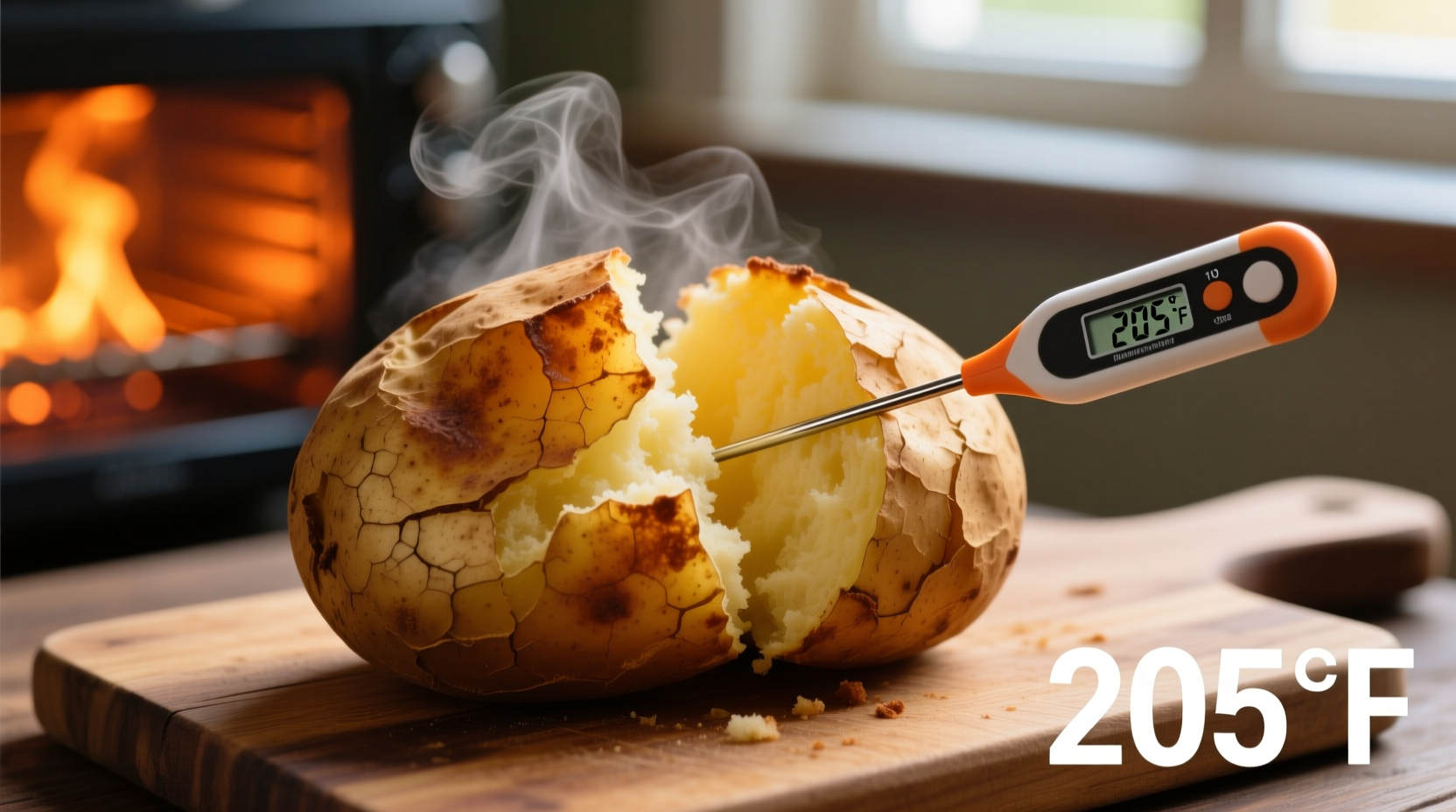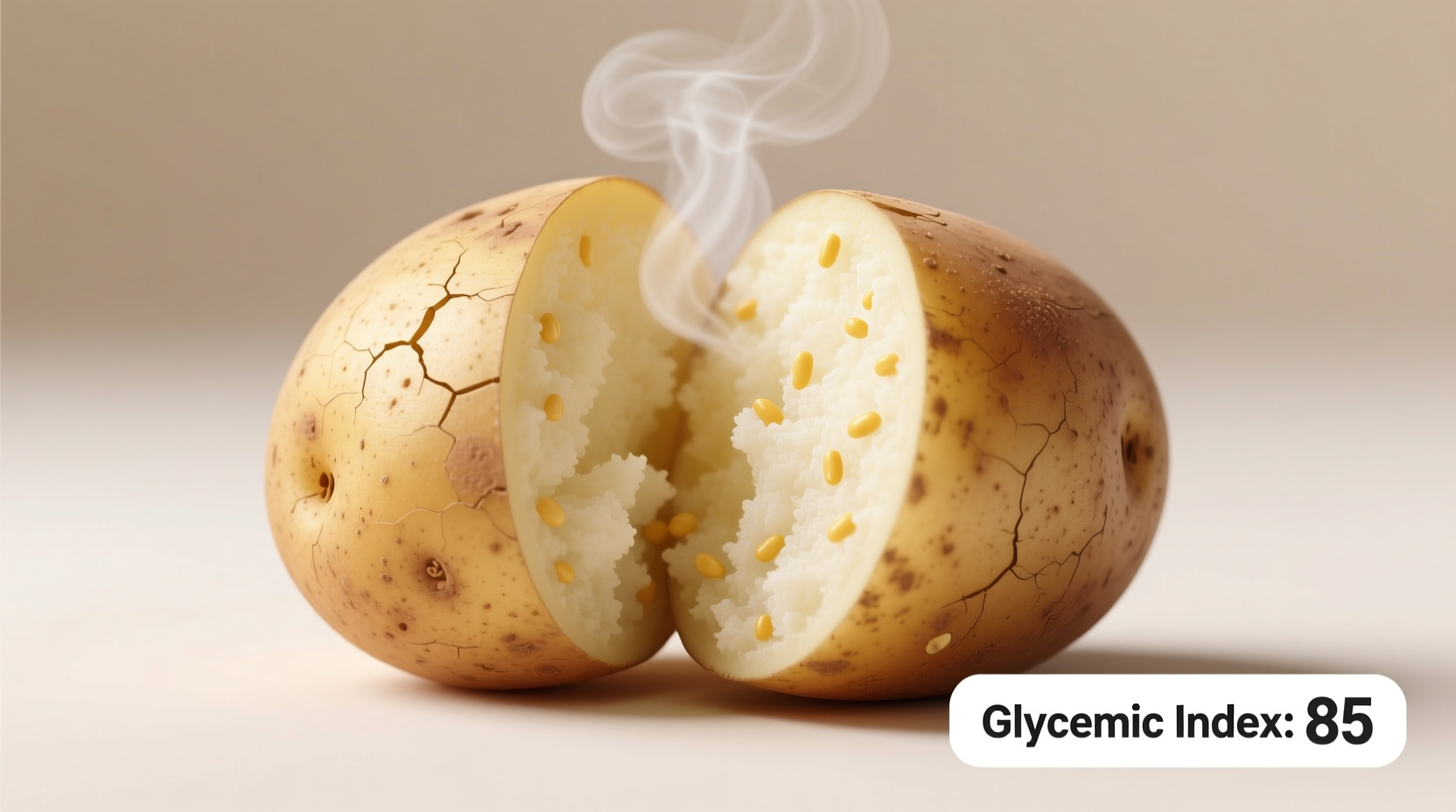The glycemic index of a baked white potato typically ranges from 85 to 95 on the 100-point scale, classifying it as a high-glycemic food that can cause rapid blood sugar spikes. However, cooling baked potatoes after cooking can reduce this value by 20-25% due to resistant starch formation, making them more blood-sugar friendly.
Understanding how baked potatoes affect your blood sugar is crucial whether you're managing diabetes, following a low-carb diet, or simply making informed food choices. This comprehensive guide delivers science-backed insights about baked potato glycemic index values, practical preparation methods to moderate blood sugar impact, and evidence-based strategies for enjoying this nutritious staple while maintaining stable glucose levels.
What Glycemic Index Really Means for Your Health
Glycemic index (GI) measures how quickly carbohydrate-containing foods raise blood glucose levels compared to pure glucose (which has a GI of 100). Foods are categorized as:
- Low GI: 55 or less
- Medium GI: 56-69
- High GI: 70 or higher
While GI provides valuable information, it doesn't tell the whole story. The glycemic load (GL) considers both the quality and quantity of carbohydrates in a typical serving, offering a more practical measure for daily eating. For example, watermelon has a high GI (72) but low GL because its carbohydrate density is relatively low.
Baked Potato Glycemic Index: The Science Behind the Numbers
When you bake a white potato, its glycemic index typically lands between 85-95, placing it firmly in the high-GI category. This high value stems from the gelatinization of starch during baking, which makes carbohydrates more readily digestible. Research published in the American Journal of Clinical Nutrition confirms that baking breaks down potato cell walls, increasing starch accessibility to digestive enzymes.
| Potato Preparation Method | Average Glycemic Index | Glycemic Load (per 150g serving) |
|---|---|---|
| Baked white potato (hot) | 85-95 | 29-33 |
| Baked white potato (cooled) | 60-70 | 21-24 |
| Boiled white potato | 70-80 | 22-26 |
| Steamed sweet potato | 44-50 | 11-13 |
This comparison reveals why preparation method significantly impacts blood sugar response. The table data comes from the University of Sydney's Glycemic Index Database, the world's most comprehensive GI reference maintained by nutrition scientists since 1995 (glycemicindex.com).
Transforming Your Baked Potato: Practical Blood Sugar Strategies
You don't need to eliminate potatoes from your diet—strategic preparation can make them more blood-sugar friendly. Implement these evidence-based techniques:
Cooling Creates Resistant Starch
Allowing baked potatoes to cool completely in the refrigerator for 24 hours increases resistant starch content by up to 25%, according to research from the National Center for Biotechnology Information. This resistant starch acts like fiber, slowing digestion and reducing blood sugar spikes. Reheating cooled potatoes maintains most of these benefits.
Pair with Protein and Healthy Fats
Eating baked potatoes with protein-rich foods like grilled chicken or healthy fats like olive oil can lower the overall glycemic response. A study in Nutrition Journal demonstrated that adding 30g of protein to a high-GI meal reduced postprandial glucose levels by 34% compared to the same meal without protein.
Choose Smaller Portions with Vinegar
Consuming smaller portions (about 100g) of baked potato with 1-2 tablespoons of vinegar can significantly reduce blood sugar impact. Research from the Journal of Functional Foods shows that vinegar's acetic acid slows gastric emptying and improves insulin sensitivity.

Context Matters: When High GI Isn't the Whole Story
While baked potatoes have a high glycemic index, their nutritional profile offers important benefits that shouldn't be overlooked. A medium baked potato with skin provides:
- 45% of your daily vitamin C needs
- 26% of potassium requirements
- Significant fiber content (especially with skin)
- Nearly half your daily vitamin B6
Nutrition experts at the Harvard T.H. Chan School of Public Health emphasize that focusing solely on GI can lead to poor food choices. They note that "whole foods with naturally occurring carbohydrates, even those with higher GI values, often contain valuable nutrients and fiber that benefit overall health." The context of your entire meal and dietary pattern matters more than any single food's GI value.
Evidence-Based Recommendations for Different Health Goals
Your approach to baked potatoes should align with your specific health objectives:
For Diabetes Management
The American Diabetes Association recommends pairing small portions of cooled baked potatoes with non-starchy vegetables and lean protein. Their 2023 Standards of Medical Care in Diabetes state: "Individuals with diabetes don't need to avoid high-GI foods entirely but should consider portion size and food combinations to moderate blood glucose responses."
For Weight Management
Research from the American Journal of Clinical Nutrition shows that the resistant starch in cooled potatoes increases satiety hormones by 20-30% compared to hot potatoes, potentially reducing overall calorie intake at subsequent meals.
For Athletic Performance
Endurance athletes may benefit from the high-GI nature of hot baked potatoes immediately after intense training sessions. The Sports, Cardiovascular, and Wellness Nutrition (SCAN) practice group explains that "high-GI carbohydrates consumed within 30 minutes post-exercise accelerate glycogen replenishment, supporting faster recovery for athletes with limited recovery time between training sessions."
Debunking Common Potato Myths
Several misconceptions persist about potatoes and blood sugar:
- Myth: All potatoes have the same glycemic impact
Fact: Varieties matter—Yukon Gold has a lower GI than Russet, and purple potatoes contain anthocyanins that may moderate blood sugar response - Myth: Sweet potatoes always have a lower GI than white potatoes
Fact: Baking increases sweet potato's GI significantly; boiled sweet potatoes have a much lower GI value - Myth: Potato skins cause blood sugar spikes
Fact: Leaving the skin on actually increases fiber content, which can lower the overall glycemic response by 10-15%
Practical Implementation: Your Baked Potato Action Plan
Transform your potato consumption with these actionable steps:
- Bake potatoes in advance and cool completely in the refrigerator before eating
- Pair with 3-4 ounces of protein and 1-2 cups of non-starchy vegetables
- Add 1-2 tablespoons of vinegar or lemon juice to your potato dish
- Keep portions to 100-150g (about the size of your fist) for blood sugar management
- Choose colorful potato varieties like purple or red potatoes for additional phytonutrients
Remember that individual responses to carbohydrates vary significantly. Continuous glucose monitoring studies published in Nature Medicine show that two people can have dramatically different blood sugar responses to the same food. Consider tracking your personal response to baked potatoes using a food and glucose diary if you're managing blood sugar concerns.
Frequently Asked Questions
Does cooling baked potatoes really lower their glycemic index?
Yes, cooling baked potatoes in the refrigerator for 24 hours increases resistant starch content by 20-25%, reducing the glycemic index from approximately 90 to 65-70. This transformation occurs because cooling allows starch molecules to reorganize into a structure that resists digestion. Reheating cooled potatoes maintains most of these benefits while improving texture and flavor.
How much baked potato can I eat if I have diabetes?
Most diabetes nutrition guidelines recommend limiting baked potato portions to 1/2 cup (about 75-100g) when served as part of a balanced meal. Pair this portion with 3-4 ounces of protein and 1-2 cups of non-starchy vegetables. For better blood sugar control, choose cooled potatoes and add vinegar or lemon juice. Always consult with your healthcare provider or registered dietitian for personalized recommendations based on your specific health status and medication regimen.
Are sweet potatoes better than white potatoes for blood sugar control?
The answer depends on preparation method. Boiled sweet potatoes have a lower glycemic index (44-50) compared to boiled white potatoes (70-80). However, baking significantly increases sweet potatoes' GI to 65-75, narrowing the difference. White potatoes contain more potassium and vitamin C, while sweet potatoes provide more vitamin A. Both can fit into a blood-sugar friendly diet when prepared properly—cooled, with skin, and in appropriate portions paired with protein and healthy fats.
What's the difference between glycemic index and glycemic load for baked potatoes?
Glycemic index (GI) measures how quickly a food raises blood sugar compared to pure glucose, while glycemic load (GL) considers both the quality (GI) and quantity of carbohydrates in a typical serving. A baked white potato has a high GI (85-95) but a moderate GL of 29-33 for a 150g serving. This distinction matters because GL provides a more realistic picture of a food's blood sugar impact in normal portion sizes. For blood sugar management, both values are important, but GL often offers more practical guidance for meal planning.











 浙公网安备
33010002000092号
浙公网安备
33010002000092号 浙B2-20120091-4
浙B2-20120091-4